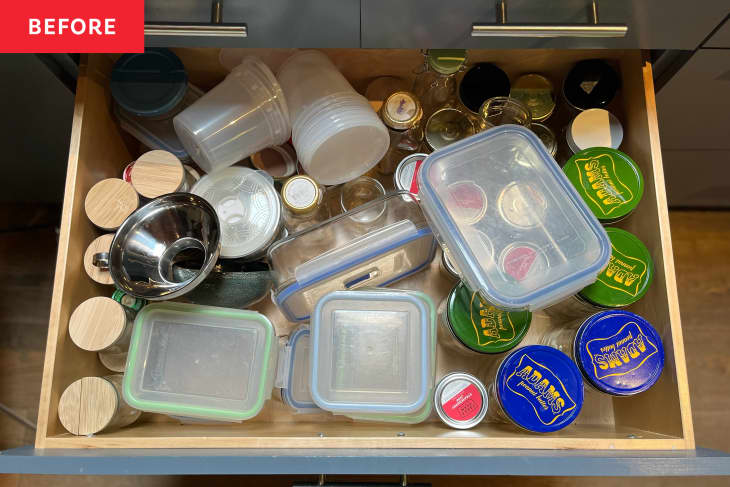I Tried the “Boundary Method” and It Got Rid of My Container Clutter

I’ve never met a jar I didn’t like, which explains the chaos of my container drawer. I periodically declutter the collection, but because it’s physically impossible for me to put a perfectly good Mason jar in the recycling bin, the drawer is overflowing again within a week.
What Is the Boundary Method of Decluttering?
According to Erica Lucas, the boundary method of decluttering is a system that “contains items together within the confines of a shelf, drawer, basket, or cube.” It allows you to keep a collection of things in an organized manner.
I need a system that forces me to limit the number of leftover containers I own, and luckily I came across one that promises to do just that: the “boundary decluttering method.”
What Is the Boundary Method of Decluttering?
Erica Lucas, a simple living blogger, describes the boundary decluttering method as a system that “contains items together within the confines of a shelf, drawer, basket, or cube.” Keep as many items as you want (!) within a designated space, Lucas says. Dana K. White of A Slob Comes Clean refers to it as the “Container Concept,” and uses the example of if you own a lot of pens, select a container, like a glass jar, to contain them and set a limit as to what you own/keep based on this selection. (It sets the boundary!)
My Mason-jar-loving heart likes the sound of that. Here’s how it works.
Step 1: Define a boundary.
Clearly, “drawer” isn’t defined enough for me, as I keep cramming in extra containers. For step one, I made a plan to establish more specific boundaries within the drawer by placing masking tape rectangles. If you have a more generous budget than zero dollars, consider these bamboo drawer dividers instead.
Step 2: Empty and clean the space.
Once I emptied the drawer, I gave it its inaugural clean. The drawer honestly wasn’t that dirty, which made me feel better about neglecting it.
Step 3: Gather *all* of the items in the category.
Some of my containers were in use or dirty, so I ran them all through the dishwasher to make sure I was considering every jar I owned.
Step 4: Pick the keepers, and restock the space.
I chose my favorites first, beginning with the glass containers. Once I established and taped off their footprint, I created masking tape rows for the various sizes of jars. I love Adams Peanut Butter jars for sourdough projects and specialty flour storage because of the wide mouth, but I limited myself to the four that would fit in a row. I did the same with the La Fermiére yogurt jars (buy the bamboo lids here), and my standard Mason jars. I decided to keep the bowl I use to store the jar funnel and extra lids, but I had to give up more containers to make space for it.
Step 5: Declutter or relocate the leftovers.
At this point in the process, I still had a counter full of jars and takeout containers. Lucas gives two options for dealing with leftovers: declutter or relocate. I decluttered the lot, as relocating just felt like kicking the organizing can down the road. Multiple neighbors in my Buy Nothing group were interested in my rejected containers, and I didn’t have to recycle anything after all.
Takeaways
This new way of thinking about a classic method of organizing has finally broken the clutter cycle in my container drawer. The firmly established boundaries make it easy for me to let go of the random mayonnaise jars that enter my kitchen, and I feel a little jolt of happiness every time I open my organized container drawer.
To maintain the system, I give away or recycle anything that doesn’t fit in the designated rectangles. If a new jar comes into my life that I simply can’t part with, I use the “one in, one out” rule and replace an old container with the new favorite.